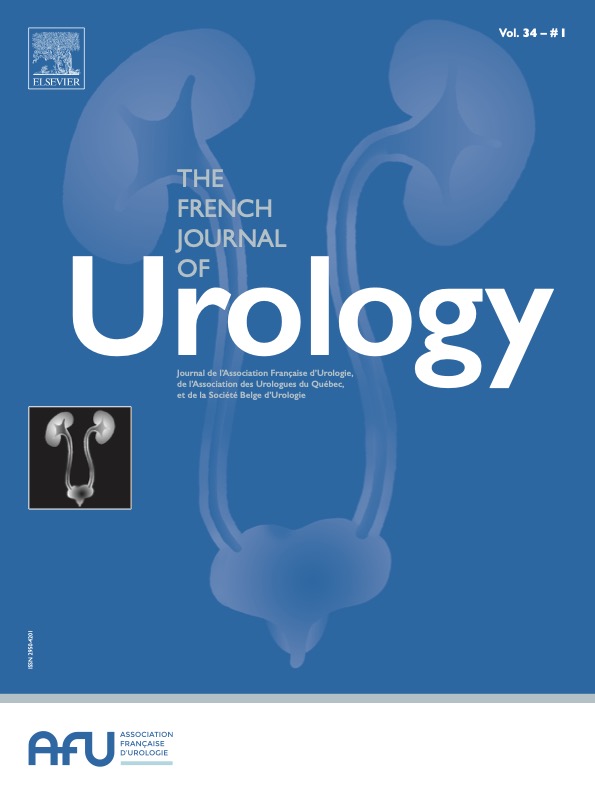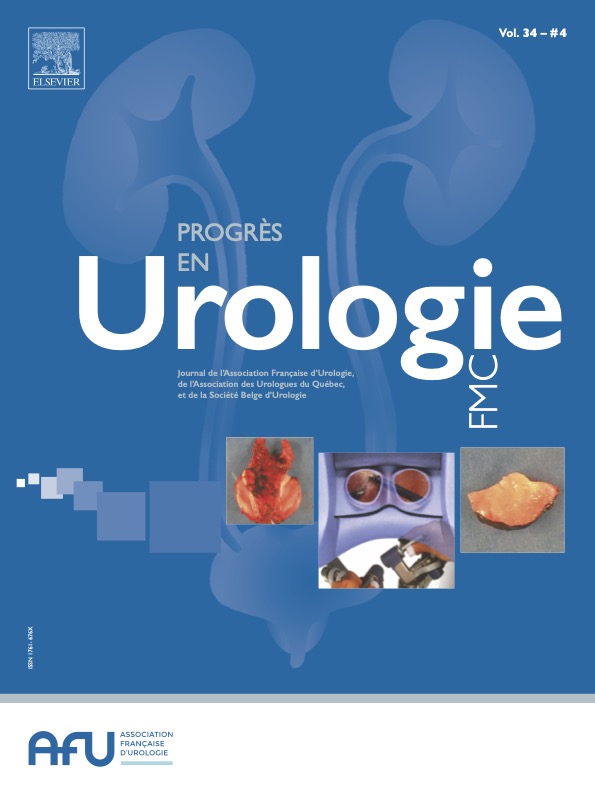|
| Antibiotic prophylaxis for ureteroscopy |
The first meta-analysis included 11 studies with 4591 patients who underwent rigid or flexible ureteroscopy [1]. No significant difference in post-ureteroscopy febrile urinary tract infections was found between the antibiotic prophylaxis group and the no antibiotic prophylaxis group (OR: 0.82; 95% CI [0.40–1.67]; P =0.59). However, the antibiotic prophylaxis group had less pyuria, defined as leukocyturia>10/mm3 (OR: 0.42; 95% CI [0.25–0.69]; P =0.0007), and less bacteriuria, defined as the presence of more than 105 bacterial colonies per mL (OR: 0.25; 95% CI [0.11–0.58]; P =0.001).
These results are consistent with those of a randomized double-blind study, not included in this meta-analysis, that found a significant decrease in pyuria in the antibiotic prophylaxis group (48.4%) compared with the no antibiotic prophylaxis group (64.7%; P =0.04) [2]. Conversely, the results suggest a non-significant decrease in the number of urinary tract infections in the antibiotic prophylaxis group compared with the no prophylaxis group (1.3% vs. 5.9%; P =0.09).
Another randomized trial showed a significant decrease in postoperative bacteriuria in the antibiotic prophylaxis group compared with the no antibiotic prophylaxis group (1.8% vs. 12.5%; P =0.026) [3]. However, as reported in previous studies, there was no significant difference in terms of postoperative urinary tract infections. Similarly, a retrospective study found no significant difference in terms of urinary tract infections between patients with preoperative antibiotic prophylaxis and patients with also one week of postoperative antibiotic therapy (2% vs. 2%; P =0.988) [4].
Concerning fever, two studies showed no benefit of antibiotic prophylaxis. Analysis of the Clinical Research Office of the Endourological Society [5] database showed no significant difference between the antibiotic prophylaxis group and the group without antibiotic prophylaxis in terms of fever (OR: 1.84; 95% CI [0.69–4.94]) and urinary tract infections (OR: 1.27; 95% CI [0.40–4.00]) [6]. Similarly, a multicenter retrospective study found no significant difference between the antibiotic prophylaxis group and the group without antibiotic prophylaxis (2.9% vs. 3.6%; P =0.5) [7].
A retrospective study found an increased risk of postoperative urinary tract infections in patients with treated preoperative bacteriuria compared with those with negative preoperative urinalysis (10.8% vs. 1.9%; P <0.005) [8]. This result was confirmed by a prospective study that reported 16.4% and 2% of patients with fever in the group with urinary tract infection treated before the intervention and in the preoperative negative urinalysis group, respectively (P <0.001) [9]. Another prospective study confirmed this increased risk (OR: 4.88; 95% CI [2.11–11.31]; P <0.001) [10].
A single-dose antibiotic prophylaxis appears to be sufficient, as suggested by a retrospective study in which the postoperative urinary tract infection rate was not significantly different between the single-dose preoperative antibiotic prophylaxis and extended antibiotic prophylaxis groups [11]. A retrospective study compared ampicillin-gentamycin prophylaxis and standard ciprofloxacin prophylaxis and found a reduction in the urinary tract infection rate with the combination (0.5% vs. 7.5%; P <0.0001) [12].
|
|
Postoperative urinary tract infection |
In a systematic review of 14 articles that included 24,373 rigid or flexible ureteroscopies, postoperative urinary tract infection was observed in 3.9% of interventions [13]. Among these urinary tract infections, 6.5% were defined as urosepsis.
The meta-analysis by Bhojani et al. (13 articles and 5597 patients) [14] found that the prognostic factors of postoperative urinary tract infection were: presence of an ureteral double J stent (OR: 3.94; P <0.001), positive preoperative urinalysis (OR: 3.56; P <0.001), ischemic heart disease (OR: 2.49; P <0.001), advanced age (mean difference: 2.7 years; P <0.002), intervention duration (mean difference: 9min; P <0.02) and diabetes (OR: 2.04; P =0.04).
A retrospective study on prognostic factors of postoperative urinary tract infection showed that in multivariate analysis, only intervention duration (P <0.01) was a significant independent predictor of urinary tract infection [15]. The cut-off value for increased risk of febrile urinary tract infection was 70minutes. These results were confirmed by another retrospective study showing that intervention duration was an independent factor in terms of risk of urinary tract infection (OR: 1.034; 95% CI [1.004–1.063]; P =0.024) [16]. The detection of a multi-drug resistant bacterium in the preoperative urine culture was also a risk factor (OR: 5.090; 95% CI [1.312–19.751]; P =0.019) (Recommendation Table 1).
|
| Ureteroscopy (retro- and ante-grade) |
A rigid ureteroscope can be used in the whole ureter. However, technical advances allow using flexible endoscopes in the ureter [17].
|
|
Ureteroscopy/ureterorenoscopy for urinary stones |
Technical advances, including miniaturization, have improved the endoscope deflection and optical performance, and the availability of dedicated disposable devices have led to an increase in the use of ureteroscopes for kidney and ureteral stones. Major technological advances have been made in the treatment of kidney stones.
For stones>2cm, percutaneous nephrolithotomy [5] remains the gold standard, but a systematic review on stones>2cm treated by laser ureteroscopy reported a cumulative stone-free rate of 91% after a mean of 1.45 procedures per patient; 4.5% of complications were higher than grade 3 [18, 19, 20, 21]. Digital endoscopes decrease the intervention time due to improved image quality [20].
Stones that cannot be extracted directly must be reduced to dust (or extracted after fragmentation). Given the difficulty of accessing the lower calyx, it may be useful to relocalize the stones in the working axis beforehand [22].
|
|
Access to the upper urinary tract |
Most interventions are performed under general anesthesia, although local or loco-regional anesthesia is possible [23]. Intravenous sedation is required also in women for distal stones [24]. The antegrade approach is a possible option for large, impacted proximal stones [25, 26, 27, 28]. The use of smaller endoscopes allows a better ureteral access with visibility, deflection and maneuverability that are comparable to those of standard ureteroscopes [29]. Single-use endoscopes provide efficacy and safety that are similar to those of reusable endoscopes, but are more expensive [30, 31]. These data were confirmed by two recent studies [32, 33].
Fluoroscopy equipment should be available in the operating room. The use of a guide wire is a safety feature during ureteroscopy/ureterorenoscopy although it is considered optional by some authors [34, 35, 36].
Ureteral dilatation may be required early in the procedure. In case of access failure, a double J stent may be inserted and a new attempt may be performed after 1–2 weeks [37].
Anatomical difficulties, such as a narrow infundibulopelvic angle, can lead to stone access failures [38]. Intervention duration longer than 90–120minutes may increase the complication rate, particularly infectious complications [39]. After 90minutes, a second intervention should be considered unless only few more minutes are needed to obtain an optimal result.
Ureteral access sheaths with hydrophilic coating are available in different calibers (internal caliber from 9 CH), and can be placed (on a guide wire) with the tip almost in the proximal ureter.
Ureteral access sheaths allow the easy and repeated access to the upper urinary tract, thus facilitating ureterorenoscopy. Their use improves the vision by allowing continuous outflow, decreases the intrarenal pressure, and may shorten the intervention duration [40] [41].
High intrarenal pressure predisposes to complications, and measures should be taken to reduce this pressure. However, presently, there is no accurate way to monitor intraoperative intrarenal pressure [42]. Intraoperative monitoring methods are currently developed and evaluated.
The insertion of ureteral access sheaths can lead to ureteral injury, the risk of which is reduced if stents are placed before the intervention [43]. The identified studies did not evaluate the long-term side effects [43, 44]. Large prospective series did not find any difference in terms of stone-free rate and ureter injury (stricture rate of ∼1.8%), but lower postoperative infectious complications [45, 46]. The use of a ureteral access sheath is safe and may be useful in case of large or multiple kidney stones, or if the procedure is likely to be long [47].
The endoscopic description of stones and renal papillae is useful for the etiological diagnosis of urinary stone disease and the prevention of recurrences (see Endoscopic description of renal papillae and stones).
The current standard for intracorporeal lithotripsy during ureterorenoscopy is the holmium: yttrium-aluminum-garnet (Ho:YAG) laser, because it is effective for all stone types [48, 49]. The laser settings are described in a dedicated chapter (see Laser – Utilization and Settings). Pneumatic systems may also be used with good results during ureteroscopy with a rigid ureteroscope[50, 51].
The objective of ureteroscopy/ureterorenoscopy is the complete stone removal or as much as possible. Stones can be extracted with endoscopic forceps or a basket and addressed for analysis (see Endoscopic description of renal papillae and stones). Only nitinol baskets can be used for ureterorenoscopy [52].
A randomized trial suggests that when treating ureteral stones, it is possible to concomitantly treat also kidney stones (even asymptomatic stones) to avoid subsequent recurrences [53].
Medical expulsive therapy (MET) after intracorporeal lithotripsy increases the stone-free rate and reduces renal colic episodes [54].
|
|
Ureteral stenting before and after ureteroscopy/ureterorenoscopy |
Routine ureteral stenting is not necessary before ureteroscopy/ureterorenoscopy, but it may facilitate access during a secondary ureteroscopy [55, 56]. However, a systematic review showed that preoperative stenting for more than 30 days was an independent risk factor of infection [57].
Prospective randomized trials showed that routine ureteral stenting after optimal uncomplicated ureteroscopy is not needed and may be associated with higher morbidity [58, 59, 60]. An ureteral catheter for a shorter time (one day) may be used, with similar results [61].
On the other hand, ureteral stents should be placed in patients with increased risk of complications [ureteral trauma, significant residual fragments (see Objectives, Results, Residual Fragments and Stones), bleeding, perforation, urinary tract infection, pregnancy, suspected infection stones], to avoid a secondary emergency procedure. The ideal stenting duration is not known. Alpha-blockers reduce the morbidity of ureteral stents and increase their tolerance [62, 63].
|
|
Medical treatments before and after an ureteroscopy |
MET before ureteroscopy may reduce the need of intraoperative ureteral dilatation, prevent ureteral trauma, and increase the stone-free rate at 4 weeks [64].
MET after Ho:YAG laser lithotripsy accelerates the spontaneous passage of fragments and reduces painful episodes [54].
After dusting, postural therapy may be proposed to facilitate the removal of dust or of residual fragments (see Postural therapy) (Recommendation Table 2).
|
| Antibioprophylaxie pour les urétéroscopies |
Une 1re méta-analyse a regroupé 11 études pour 4591 patients ayant eu une urétéroscopie rigide ou souple [1]. Celle-ci ne met pas en évidence de différence significative pour les infections urinaires fébriles post urétéroscopie dans le groupe antibioprophylaxie par rapport au groupe sans antibioprophylaxie (OR : 0,82 ; 95 %IC [0,40–1,67] ; p =0,59). Cependant, le groupe antibioprophylaxie était caractérisé par moins de pyurie définie comme une leucocyturie>10/mm3 (OR : 0,42 ; 95 %IC [0,25–0,69] ; p =0,0007) et moins de bactériurie définie par la présence de plus 105 de colonie bactérienne par mL (OR : 0,25 ; 95 %IC [0,11–0,58] ; p =0,001).
Ces résultats sont concordants avec ceux d’une étude randomisée en double aveugle, non incluse dans la méta-analyse de [1]. Cette étude a mis en évidence une diminution significative de la pyurie dans le groupe antibioprophylaxie (48,4 %) par rapport au groupe sans antibioprophylaxie (64,7 % ; p =0,04) [2]. En revanche, les résultats suggèrent une diminution non significative du nombre des infections urinaires dans le groupe antibioprophylaxie par rapport au groupe sans antibioprophylaxie (1,3 % vs 5,9 % ; p =0,09).
Un autre essai randomisé a mis en évidence une diminution significative de la bactériurie postopératoire dans le groupe antibioprophylaxie par rapport au groupe sans antibioprophylaxie (1,8 % vs 12,5 % ; p =0,026) [3]. Cependant, comme rapporté dans les études précédentes, il n’y avait pas de différence significative en termes d’infection urinaire postopératoire. Il en est de même dans une étude rétrospective qui ne mettait pas en évidence de différence significative en termes d’infection urinaire entre des patients avec une antibioprophylaxie peropératoire et une antibiothérapie prolongée d’une semaine postopératoire (2 % vs 2 % ; p =0,988) [4].
En termes de fièvre, 2 études mettent en évidence l’absence d’intérêt d’une antibioprophylaxie.
L’analyse de la base de données du CROES ne montre pas de différence significative entre le groupe antibioprophylaxie et le groupe sans antibioprophylaxie en termes de fièvre (OR : 1,84 ; 95 %IC [0,69–4,94]) et d’infection urinaire (OR : 1,27 ; 95 %IC [0,40–4,00]) [5]. Il en était de même dans une étude rétrospective multicentrique qui ne montrait pas de différence significative entre le groupe antibioprophylaxie et le groupe sans antibioprophylaxie (2,9 % vs 3,6 % ; p =0,5) [6].
Une étude rétrospective a mis en évidence un risque accru d’infection urinaire postopératoire pour les patients ayant une bactériurie préopératoire traitée en comparaison de ceux ayant un ECBU préopératoire stérile (10,8 % vs 1,9 % ; p <0,005) [7]. Ce résultat est confirmé dans une étude prospective qui rapporte 16,4 % de fièvre dans le groupe ECBU préopératoire traité contre 2 % dans le groupe ECBU préopératoire stérile (p <0,001) [8]. Une autre étude prospective confirme la majoration de ce risque (OR : 4,88 ; 95 %IC [2,11–11,31] ; p <0,001) [9].
Une antibioprophylaxie unique semble suffisante, comme suggéré par une étude rétrospective : il n’y avait pas de différence significative en termes d’infection urinaire postopératoire entre le groupe antibioprophylaxie peropératoire unique et antibioprophylaxie prolongée [10]. Lorsque la bi-antibioprophylaxie ampicilline-gentamycine a été comparée à l’antibioprophylaxie standard par ciprofloxacine dans une étude rétrospective, une réduction du taux d’infection urinaire postopératoire a été observée (0,5 % vs 7,5 % ; p <0,0001) [11].
D’après une revue systématique de 14 articles évaluant 24373 urétéroscopies rigides ou souples, une infection urinaire postopératoire était présente dans 3,9 % des cas [12]. Parmi ces infections urinaires, 6,5 % étaient définies comme sepsis urinaire.
La méta-analyse de Bhojani N13 a analysé 13 articles pour un total de 5597 patients [13]. Les facteurs pronostiques d’une infection urinaire postopératoire étaient : une sonde JJ en place (OR : 3,94 ; p <0,001), un ECBU préopératoire positif (OR : 3,56 ; p <0,001), une cardiopathie ischémique (OR : 2,49 ; p <0,001), l’âge avancé (différence moyenne de 2,7ans ; p <0,002), la durée opératoire (différence moyenne de 9min ; p <0,02) et le diabète (OR : 2,04 ; p =0,04).
Une étude rétrospective a recherché les facteurs pronostiques d’infection urinaire postopératoire. En analyse multivariée, seule la durée (p <0,01) était un facteur significativement indépendant en termes de prédiction d’infection urinaire [14]. La valeur seuil pour un risque accru d’infection urinaire fébrile était de 70minutes. Ces résultats ont été confirmés dans une autre étude rétrospective qui rapporte que le temps opératoire était un facteur indépendant en termes de risque d’infection urinaire (OR : 1,034 ; 95 %IC [1,004–1,063] ; p =0,024) [15]. La présence d’une BMR sur l’ECBU préopératoire était également un facteur de risque (OR : 5,090 ; 95 %IC [1,312–19,751] ; p =0,019) (Tableau de recommandations 1).
|
| Urétéroscopie (URS, rétro- et antégrade) |
Un URS rigide peut être utilisé dans tout l’uretère. Pour autant, les progrès techniques permettent aussi l’usage d’endoscopes souples dans l’uretère [17].
|
|
Urétéroscopie/urétérorénoscopie (URS/URSS) pour calculs du rein |
Les améliorations techniques dont la miniaturisation, l’amélioration de la déflexion et des performances optiques des endoscopes, la mise à disposition de consommables dédiés ont conduit à un usage accru des urétéroscopes pour les calculs rénaux comme ceux de l’uretère. Des progrès technologiques majeurs ont été accomplis pour le traitement des calculs du rein.
En cas de calcul de plus de 2cm, la NLPC reste la référence mais une revue systématique concernant les calculs de plus de 2cm traités par URS laser faisait état d’un taux de SFR cumulé de 91 % après 1,45 intervention en moyenne par patient ; 4,5 % de complications étaient au-dessus d’un grade 3 de Clavien [65, 18, 19]. Les endoscopes numériques permettent un gain de temps opératoire du fait de l’amélioration de la qualité d’image [18].
Les calculs qu’on ne peut extraire directement doivent être pulvérisés (ou extraits après fragmentation). Compte-tenu de la difficulté d’accès au calice inférieur, il peut être utile de remettre dans l’axe de travail préalablement les calculs qui y sont [20].
La plupart des interventions sont faites sous anesthésie générale, même si une anesthésie locale ou locorégionale est possible [21]. La sédation intraveineuse est souhaitable même chez une femme pour un calcul distal [22]. L’abord antégrade est une option possible pour les calculs proximaux volumineux, impactés [23, 24, 25, 26]. L’utilisation de plus petits calibres d’endoscopes permet un meilleur accès urétéral avec une visibilité, une déflexion et une manœuvrabilité comparables à celle des urétéroscopes standards [27]. Les endoscopes à usage unique permettent une efficacité et une sécurité comparables à celles des réutilisables malgré la question d’un surcoût [28, 29]. Ces données ont été confirmées dans 2 études récentes [30, 31].
Un équipement de fluoroscopie doit être disponible dans la salle d’opération. L’usage d’un guide est une sécurité au cours d’une URS ou URSS bien que certains auteurs le considèrent comme facultatif [32, 33, 34].
Une dilatation urétérale peut être nécessaire en début d’intervention. En cas d’échec d’accès, la pose de sonde JJ suivie d’une nouvelle tentative après 1 à 2 semaines est une alternative [35].
Des difficultés anatomiques, comme un angle infundibulo-pyélique étroit, peuvent conduire à des échecs d’accès aux calculs [36]. Une durée opératoire au-delà de 90 à 120min peut conduire à une augmentation des taux de complication notamment infectieuses [37]. À 90min de travail intra-rénal, il faut considérer une 2e intervention sauf s’il ne reste que quelques minutes de travail pour obtenir un résultat optimal.
Les gaines d’accès urétéral à revêtement hydrophile, qui sont disponibles en différents calibres (calibre interne à partir de 9 CH), peuvent être mises en place (sur un fil guide) avec l’extrémité placée le plus souvent dans l’uretère proximal.
Les gaines d’accès urétéral permettent un accès facile et répété au haut appareil urinaire et facilitent ainsi l’URSS. Leur utilisation améliore la vision en permettant un lavage continu, diminue la pression intrarénale et réduit possiblement le temps opératoire [38] [39].
Une pression intrarénale élevée prédispose aux complications de l’urétérorénoscopie, et des mesures devraient être utilisées pour réduire cette pression, mais Il n’existe actuellement aucun moyen précis de monitorer la pression intrarénale peropératoire [40]. Des méthodes de monitorage peropératoire sont en cours de développement et d’évaluation.
L’insertion de gaines d’accès urétéral peut entraîner des lésions urétérales dont le risque est diminué en cas de drainage préalable [41]. Les études identifiés n’ont pas évalué les effets secondaires à long terme [41, 42]. Alors que des séries prospectives plus importantes n’ont pas montré de différence en termes de SFR et de lésions de l’uretère (taux de sténose d’environ 1,8 %), elles ont montré des complications infectieuses postopératoires plus faibles [43, 44]. L’utilisation d’une gaine d’accès urétérale est sûre et peut être utile en cas de calculs rénaux volumineux ou multiples ou si l’intervention s’annonce longue [45].
La visualisation endoscopique (REC) aussi la description des papilles (REP) est utile pour le diagnostic étiologique de la lithiase urinaire et la prévention des récidives (cf. RECOMMANDATION 2022 DU COMITÉ LITHIASE DE L’AFU : Reconnaissance endoscopique des papilles et des calculs ).
Le standard actuel de lithotritie endocorporelle pour l’URSS est le laser holmium : yttrium-aluminium-grenat (Ho :YAG), car il est efficace sur tous les types de calculs [46] [47]. Les paramétrages laser sont décrits dans un chapitre dédié (cf. RECOMMANDATION 2022 DU COMITÉ LITHIASE DE L’AFU : LASER - UTILISATIONS ET PARAMETRAGES). Les systèmes pneumatiques peuvent par ailleurs être efficacement utilisés pour l’URS avec les urétéroscopes rigides [48, 49]).
L’objectif de l’URS/URSS est un traitement maximal du calcul. Les calculs peuvent être extraits à l’aide de pinces endoscopiques ou de paniers pour analyse. Seuls les paniers en nitinol peuvent être utilisés pour une urétérorénofibroscopie [50].
Lors du traitement des calculs urétéraux, il est possible de traiter dans le même temps des calculs rénaux même asymptomatiques pour éviter des récidives ultérieures, tel que suggéré dans un essai randomisé [51].
La thérapie médicale expulsive après une lithotritie endocorporelle augmente le taux de SFR et réduit les épisodes de colique néphrétique [52].
|
|
Endoprothèses urétérales avant et après l’URS/URSS |
La pose systématique d’une endoprothèse urétérale n’est pas nécessaire avant URS/URSS. Cependant, elle peut faciliter l’accès lors d’une URS secondaire [53, 54]. Toutefois, une revue systématique a montré que la durée de drainage préopératoire>30jours était un facteur de risque infectieux indépendant [55].
Des essais prospectifs randomisés ont montré que la pose systématique d’une endoprothèse urétérale après une URS optimale non compliquée n’est pas et pourrait être associée à une morbidité plus élevée [56, 57, 58]. Une sonde urétérale pour une plus courte durée (un jour) peut également être utilisée, avec des résultats similaires [59].
En revanche, les endoprothèses urétérales devraient être posées chez les patients avec risque accru de complications (traumatisme urétéral, FR significatifs (cf. RECOMMANDATION 2022 DU COMITÉ LITHIASE DE L’AFU : OBJECTIFS, RESULTATS, FRAGMENTS ET CALCULS RESIDUELS), hémorragie, perforation, infection urinaire ou grossesse, calculs supposés infectieux), afin d’éviter un recours secondaire en urgence. La durée idéale de drainage n’est pas connue. Les alpha-bloquants réduisent la morbidité des endoprothèses urétérales et augmentent leur tolérance [60, 61].
|
|
Traitements médicaux avant et après l’urétéroscopie URS |
La thérapie médicale expulsive (TME) avant URS pourrait réduire le besoin de dilatation urétérale peropératoire, prévenir les traumatismes urétéraux et augmenter le taux de SFR à 4 semaines [62].
La TME après une lithotritie au laser Ho :YAG accélère le passage spontané des fragments et réduit les épisodes douloureux [52].
Après pulvérisation, une posturothérapie peut être proposée pour faciliter l’élimination de la poudre ou des fragments résiduels (FR) rénaux (cf. RECOMMANDATION 2022 DU COMITÉ LITHIASE DE L’AFU : OBJECTIFS, RESULTATS, FRAGMENTS ET CALCULS RESIDUELS et RECOMMANDATION 2022 DU COMITÉ LITHIASE DE L’AFU : POSTUROTHÉRAPIE) (Tableau de recommandations 2).
The disclosures of the authors are described in 2022 RECOMMENDATIONS OF THE AFU LITHIASIS COMMITTEE: Evidence acquisition.









